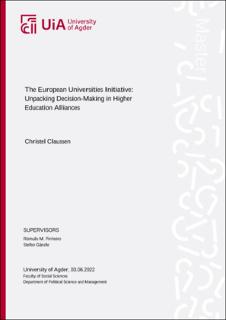| dc.description.abstract | The European Universities Initiative (EUI) is a relatively new scheme of higher education
collaboration and is set out to create multilateral alliances between higher education
institutions across Europe, working towards strengthening quality and competitiveness in
higher education and ultimately becoming `the universities of the future ́. The pilot call in
2019 resulted in the establishment of 17 alliances, and the second call in 2020 resulted in 24
new alliances. Altogether there are now 41 higher education alliances including universities
from both the European Union member states and partner countries. Although international
strategic alliances in the field of higher education and research collaboration have become a
new empirical fact (Thomas, 2014), there still is a gap in understanding how these bodies are
being organised and governed. This study seeks to address this lacuna by investigating how
decision-making processes take place in two EUI alliances – Circle U. and FORTHEM. The
study is qualitative in character, focusing on semi-structured interviews with key actors from
the alliances and review of relevant literature and policy documents. Conceptually the study
builds on decision theory, whereby four decision-making models have been chosen and
outlined; the rational actor model, the collegial model, the political model and the garbage can
model.
The study investigates two main stages in the alliances – the initiation stage and the
consolidation stage. Key findings from the initiation stage reveal that both Circle U. and
FORTHEM were formed based on existing connections between the participating universities,
however they also revealed that Circle U. was more strategically selective than FORTHEM at
this stage. In the consolidation stage, the findings reveal Circle U. and FORTHEM as having
formalised and hierarchical structures, although decision-making power have been delegated
downwards to the lower levels. It is also shown that much of the structure and goals had
already been chosen ex-ante by the Commission. Regarding decision-making the findings
demonstrate that decisions are made by consensus in both alliances, and that resource
dependency, soft power, trust and tensions underpin these decision-making processes.
Keywords: alliances, collaboration, European Universities Initiative, internationalisation,
Circle U., FORTHEM, decision-making, decision theory | |
